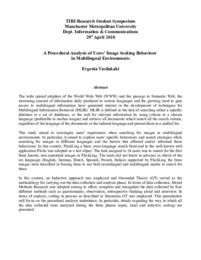| dc.description.abstract | The wide spread adoption of the World Wide Web (WWW) and the passage to Semantic Web, the
increasing amount of information daily produced in various languages and the growing need to gain
access to multilingual information have generated interest in the development of techniques for
Multilingual Information Retrieval (MLIR). MLIR is defined as the task of searching either a specific
database or a set of databases, or the web for relevant information by using criteria in a chosen
language (preferable in mother tongue) and retrieve all documents which match all the search criteria,
regardless of the language of the documents or the indexed language and present them in a unified list.
This study aimed to investigate users' experiences when searching for images in multilingual
environments. In particular, it aimed to explore users' specific behaviours and search strategies while
searching for images in different languages and the factors that affected and/or informed these
behaviours. In this context, FlickLing a basic cross-language search front-end to the well-known web
application Flickr was adopted as a test object. The task assigned to 24 users was to search for the first
three known, non-annotated images in FlickLing. The users did not know in advance in which of the
six languages (English, German, Dutch, Spanish, French, Italian) supported by FlickLing the three
images were described in forcing them to use both monolingual and multilingual modes to search for
these.
In this context, an Inductive approach was employed and Grounded Theory (GT) served as the
methodology for carrying out the data collection and analysis phase. In terms of data collection, Mixed
Methods Research was adopted aiming to offset, complete and triangulate the data collected by four
different methods such as questionnaire, observation, retrospective thinking aloud and interview. In
terms of analysis, coding in process as described in Straussian GT was employed. This presentation
will focus on the procedural analysis undertaken. In particular, details regarding the way in which all
the data collected were analyzed during the three phases (open, axial and selective coding) are
presented. | en |
